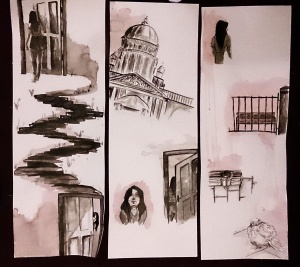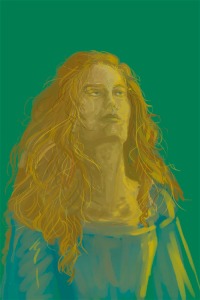The Door
Posted: March 24, 2014 Filed under: Field, Individual | Tags: Belfast, comic, field, illustration, ink Leave a comment
I wanted to make a comic about someone going through a magic door and discovering themselves in front of Belfast City Hall. I wanted it to be quite a subdued comic, and I wanted it to be ambiguous. This isn’t the usual format I would use for my comics, and so I’m quite happy with the outcome, particularly because it is experimental, as far as I’m concerned. The story is open to interpretation, and it’s supposed to be. I want this comic to reflect the “hidden” side of Belfast by letting other people ponder over what they think it means.
Experimentation
Posted: March 24, 2014 Filed under: Field, Individual | Tags: city, experimentation, field, illustration Leave a commentAfter my big conversation with Chris, I went and did some experimentation in my sketchbook and on loose A1 pages once I had the group project sorted out. I’ve been very slow with this project, therefore, most of what I have up to now is just experimental pieces designed to rekindle my motivation and interest. I enjoyed doing these quite a bit because I refused to let myself try to do anything in particular, and just focused on playing with my materials.
Group: Presentation and Final Summary Thoughts
Posted: March 23, 2014 Filed under: Field, Group Work | Tags: field, group Leave a commentWe gave our final presentation for group work there last Tuesday, and got to watch everyone else’s presentations while we were at it. It was nice to see what every else had been up to over the last few weeks, some people had produced really amazing work, and it was good to hear about how each group had different trials and tribulations in regards to getting their work done and how well they melded together. It’s always going to be difficult, as far as I can see anyway, to take a bunch of individuals and have them work together. It’s manageable, obviously, but difficult.
In the case of my own group, there was five of us, which is always going to be a bit of an awkward number, and we’re all quite strong minded with our own thoughts about how things should be done. We managed to reconcile our ideas eventually, even when I felt that we were overcomplicating things – still, it was a good idea, albeit an ambitious one for the timescale we had. Time constraints were probably the hardest thing to work within, especially given that we had other work due for individual field and constellation. For me, that particular snag had me lose all motivation and find all my work nauseatingly stagnant, but I’ve talked about that before. I’m used to having several projects run along side one another, it was similar in my BTEC. We’d have our fine art projects, print projects, ceramic projects and etc all at the same time, and it was fine, provided you organised your time accordingly. However, due to losing all motivation in my own work, I was forced over the last few weeks to adapt a sort of… one track mindset in order to produce the required work for group, since that was the deadline that came first. I had the work ready each time the others needed to see it, which was useful, I think, especially when it came to Brogan and Andy doing the filming.
The presentation itself went off fairly well, we had a few moments where the wrong person spoke over the wrong slide, and a technological problem when the internet played up when we were trying to play one of our films from youtube. Other than that, we all spoke well and I’m glad that we were able to put across our ideas fairly succinctly.
As for how we worked as a group, well, we all had our moments of being unhappy with one person or the other, but most of these issues were resolved with dialogue and compromise. Compromise was a big thing in our group, and there were a few moments where I felt like I ought to just suck it up and work on. So I did, and I didn’t spend too long ruminating on the problems, and we all got our work done. It’ll be interesting if we do manage to get an exhibition space, because I do think that the final piece will look well in a gallery environment.
For me, as someone who prefers to work on my own things rather than with groups, that was something to get used to. Having to reply on other people to get their own work done was something of a new experience, and it was rewarding in the way that, yes, everyone did get their own piece done and to a good quality, but I found that we needed perhaps more communication than we ended up having in order to tie things together properly. This is just as much my fault as it was anyone else’s, as we all had to make sure we were communicative.
Overall, I think we worked pretty well together, and though we all had our moments, we were able to resolve them through discussion and compromise.
Group: Final images
Posted: March 17, 2014 Filed under: Field, Group Work | Tags: field, group, illustration 1 Comment- Final1
- Final2
- Final3
Final images for the group field project. As you can see, we changed the last image to include the girl as it was important to show the three of our characters together in this tragic moment. On a personal level, I’m a little disappointed as I don’t feel they are as strong or as poignant as they could be, but for all intents and purposes, they do the job. I’ve also found that they don’t look as well in photo form as they do in real life. I think this is because some details have been lost in the photographs.
Group: Colour keys
Posted: March 17, 2014 Filed under: Field, Group Work | Tags: field, group, illustration 1 Comment- Key1
- Key2
- Key3
Colour keys and initial compositions for group. While I like the last one, I think it should also show the girl as she is the instigator of the tale.
Posted: March 4, 2014 Filed under: Other Work | Tags: digital painting, painting, personal, practise, warm up Leave a comment
I did the above quite quickly as some digital painting practise to warm up before starting paintings for my individual field project, and just felt like sharing it, since I was using a different painting technique than I usually do, and did it pretty fast, without reference, and with only a vague idea of what I was going for. It’s not often I use reference pictures in my work anyway, only on the occasions when I’m really stuck will I look them up, but I felt it was relevant to mention that here because there was something quite nice and freeing about painting for painting’s sake with no prior plan or real thought about what I was creating.
Thoughts about my own work
Posted: March 3, 2014 Filed under: Field, Individual, Subject | Tags: field, motivation, personal, project Leave a commentA while ago Chris mentioned that when he was marking our work, he’d seen personal work folders on blogs and so on, and that he wants us to somehow reconcile what we do for university with what we produce in our own time. I’ve heard this kind of thing before… you know, bringing our personal and studious practises together, and I’d love to be able to do that. The problem is that I have absolutely no clue how to. My personal work is so far removed from any of the briefs we’ve had that I’m uncertain of how I can merge that work without it simply being overbearing for what that particular brief is asking us to do. Nevertheless, it’s an interesting comment, and it is something I feel like I ought to work on.
There’s an illustrator I adore, and recently she was asked by someone to give some advice on how to start drawing. It was simple, all she told them (amongst other things but this truly sums up the sentiment) was, “Draw what you like.”
That little statement has made a huge impression on me over the last few days, and all of a sudden, I’ve found myself scrutinising my own work, and wondering, “Did I draw this because I was excited and I wanted to, or because it was a means to an end?” Unfortunately, as far as university work is concerned, the latter has been the answer to most of those questions. And I don’t like that, because I want to be excited about all of my work, but I’m not, and in particular, I don’t feel motivated about this current brief on The City that we have, and due to that, I’ve produced not as much work as I usually would, and not to the same standard.
There’s only one way to change that really, and that’s to take Leela’s advice.
Draw what you like.
Draw what you like.
Draw. What. You. Like.
If I just change this brief to draw what I like without concerning myself overly with what I think it ought to be, rather than what it can be and is, then I feel like I’d be much happier in myself and with my work. I’d probably even be motivated too.
–
I wrote the above on the 25th February, but didn’t publish it for some reason. Today I had a tutorial with Chris, about the very same issues I discussed in this post, plus a few other things. I feel like my work is too save, too comfortable. I don’t want to make safe and comfortable work, I want to make work that makes people stop and look. I want something that demands attention and provokes thought. I need to shake something up.
So I got some advice in order to take my work down a new and different direction, and, to be honest, it was just really reassuring to hear that I can actually do that, rather than being held ransom to what I said I wanted to look at at the start of the brief. I can unite the start of the brief with the new direction, too, though we’ll have to see how that goes. I can switch media, combine elements, listen to the advice I was given, and really go for something here.
The category is Hidden City, there is so much I can do with that, and as I said, I don’t need to be held to what I did at the start, which is obviously incredibly handy. We had Monday Muse today (which I’ve discussed in a separate post) but it got me thinking, and I finally feel like I have some direction to head towards as far as this project is concerned.








Recent Comments